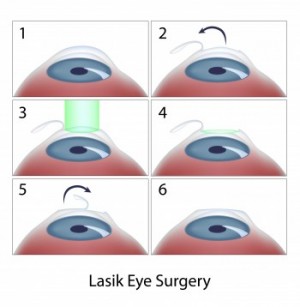LASIK vs PRK – To Flap or Not to Flap
Written by Dr. David Evans Last modified on April 22, 2019
When it comes to discussing laser refractive surgery, I often hear questions about which procedure is best: LASIK, PRK, LASEK, EPI-LASIK, etc. The basic differentiator between these procedures is whether or not a corneal flap is created (the flap is a tiny layer of corneal tissue). During LASIK a blade — or today more commonly a laser — creates the flap. The flap is folded back, the underlying corneal tissue reshaped and the flap is replaced.

As a result of improvements in technology related to flap creation, LASIK has become the most popular and widely used of all the laser refractive surgery procedures (by a wide margin). This is primarily because the other procedures require that the front surface of the cornea be treated during the procedure. And as you might expect, the cornea is very sensitive to touch. In fact, the cornea has the most nerve endings of any tissue in the body. After one of the non-flap procedures, there can be some discomfort for a day or two. Another reason LASIK is so popular is that vision improvement with LASIK is immediate, while the non-flap procedures can require a few months to achieve crystal clear vision.
Even though LASIK is the most popular of the procedures, the non-flap procedures have many good attributes that should be considered when evaluating refractive surgery. For instance, since the flap requires the creation of a tiny layer of corneal tissue, patients with extremely thin corneas may not have enough tissue to create the flap. This is particularly true for patients who have high myopia and larger portions of the cornea tissue must be removed by the laser in order to create clear vision. There simply is not enough thickness to create the flap and reshape the cornea. Also, patients with excessive dry eye are better candidates for non-flap versus flap procedures, because creation of the flap can influence dry eye. Fortunately, the diagnostic technology today is top notch, so eye doctors can readily determine corneal thickness or the presence of dry eye in helping you make a decision about surgery.
Oftentimes cost is the driving factor when selecting a treatment. However, the cost of LASIK vs PRK and the other non-flap procedures is typically similar, though some practices may charge less for PRK, since a second laser is not needed to create the flap.




